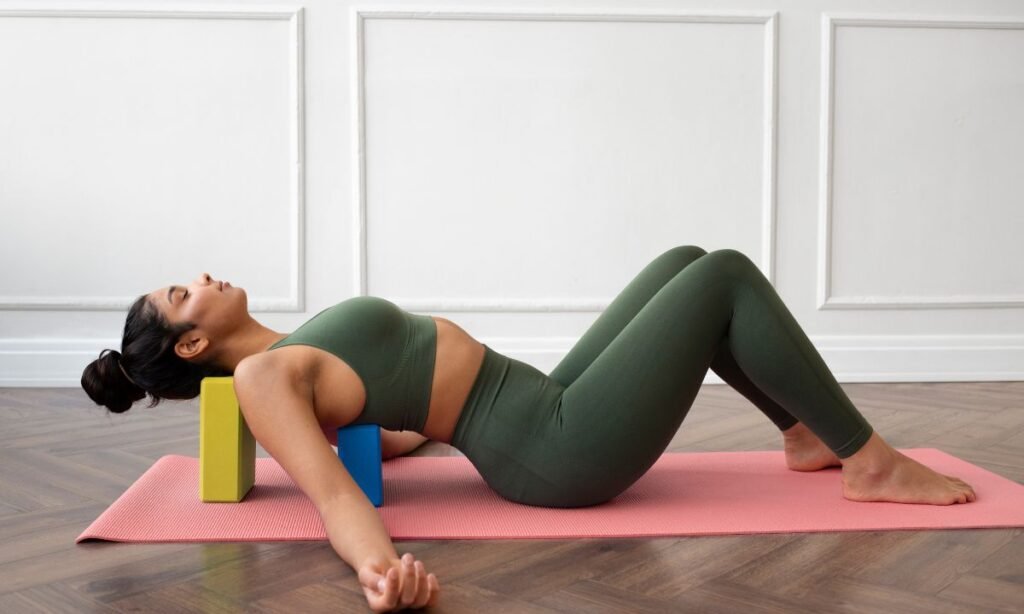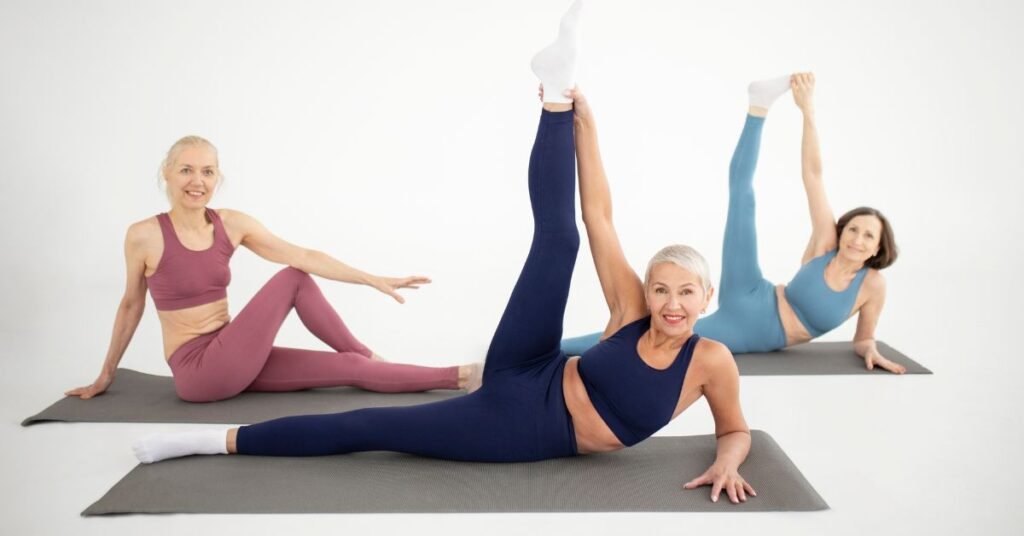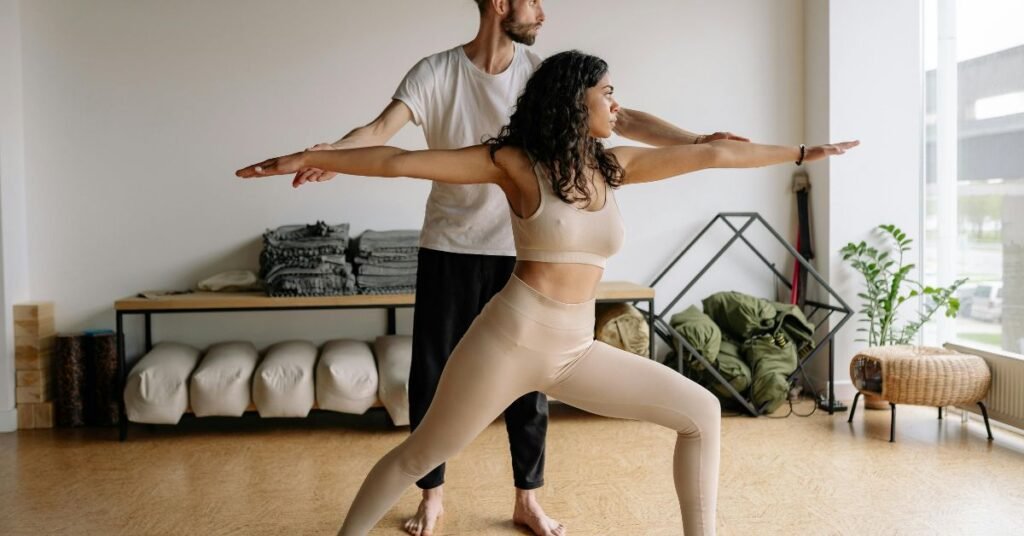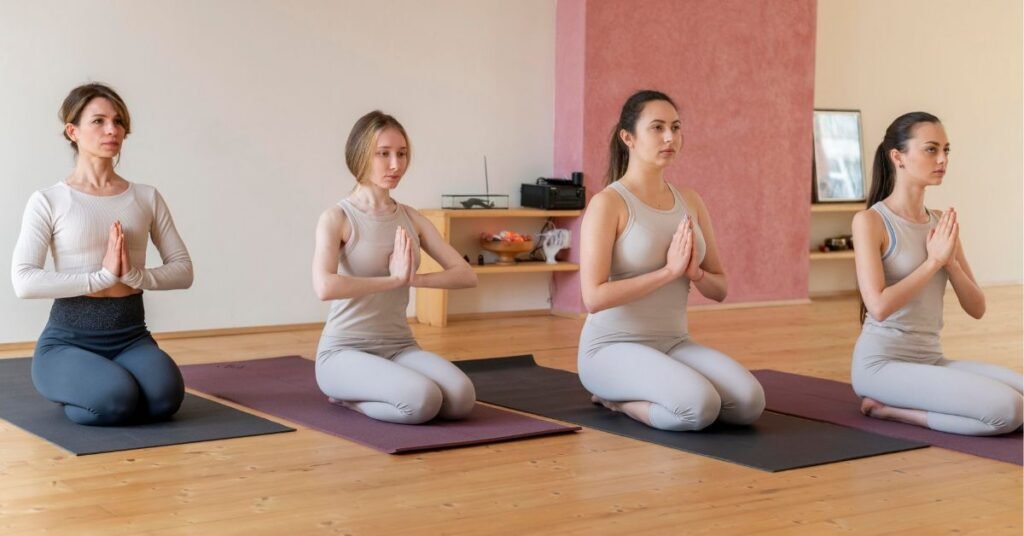Introduction
Ever feel like you need a break from the hustle and bustle of life? You’re not alone! Many people turn to yoga for relief, but did you know that there are different styles of yoga with different benefits? One of the most relaxing and healing forms is Restorative Yoga.
In this blog, we’ll explore the benefits of Restorative Yoga and answer a common question: What is the difference between yoga and Restorative Yoga? If you’re looking for a practice that helps you slow down, release stress, and heal both body and mind, keep reading!
What Is Restorative Yoga?
Restorative Yoga is a gentle, slow-paced practice that focuses on deep relaxation. Unlike other styles of yoga that involve fast movements, balancing poses, or intense stretching, Restorative Yoga is all about stillness, support, and surrender.
Here’s what makes Restorative Yoga unique:
- Passive Poses: You hold poses for long periods (typically 5-20 minutes).
- Use of Props: Bolsters, blankets, and blocks support your body so you can fully relax.
- Deep Breathing: Encourages the nervous system to shift into “rest and digest” mode.
- Minimal Effort: Unlike traditional yoga, you don’t engage your muscles much.
Think of it as yoga’s answer to a nap—except better because it restores body and mind!
What Is the Difference Between Yoga and Restorative Yoga?
Yoga, in general, refers to a broad practice that includes movement (asanas), breathwork (pranayama), and meditation. There are many styles, from fast-paced Vinyasa to the sweat-inducing Bikram. Restorative Yoga, however, is in a league of its own.
Here’s a simple comparison:
| Feature | Traditional Yoga | Restorative Yoga |
|---|---|---|
| Pace | Moderate to fast | Slow and gentle |
| Focus | Strength, flexibility, balance | Relaxation, healing, stress relief |
| Breathing | Coordinated with movement | Deep and slow |
| Effort Level | Moderate to high | Minimal effort |
| Props Used? | Sometimes | Always |
| Duration of Poses | 5-60 seconds | 5-20 minutes |
In short, if yoga is a workout, Restorative Yoga is a retreat. It’s ideal for anyone looking to recover from stress or injury, or simply needing to slow down.
Readmore: Yin Yoga Sequence for Relaxation: A Step-by-Step Guide to Deep Rest
Readmore: Power Yoga vs. Traditional Yoga
10 Amazing Benefits of Restorative Yoga
1. Reduces Stress and Anxiety
Restorative Yoga activates the parasympathetic nervous system, which lowers stress hormones like cortisol. This shift helps reduce anxiety and brings a deep sense of calm.
2. Enhances Flexibility Without Straining Muscles
Since the poses are held for longer, your body naturally opens up. This gentle stretching increases flexibility without the risk of injury.
3. Supports Deep Sleep
Having trouble sleeping? Restorative Yoga promotes relaxation, making it easier to fall asleep faster and sleep deeper.
4. Boosts the Immune System
Chronic stress weakens immunity, but deep relaxation boosts it. The calming effect of Restorative Yoga can enhance your body’s ability to fight illness.
5. Relieves Chronic Pain
For those suffering from back pain, migraines, or joint issues, this gentle practice reduces tension and inflammation, providing relief without medication.
6. Encourages Mindfulness and Mental Clarity
Since you’re holding poses for longer, your mind has time to slow down, reflect, and reset. It’s like meditation but with extra comfort!
7. Balances the Nervous System
Unlike intense workouts that increase stress hormones, Restorative Yoga calms the nervous system. This can help with issues like high blood pressure and heart rate irregularities.
8. Improves Digestion
A calm nervous system means a better-functioning digestive system. Poses that involve gentle twists can also help with bloating and gut health.
9. Enhances Mood and Emotional Well-being
By reducing stress and tension, Restorative Yoga naturally lifts your mood and promotes a more positive outlook on life.
10. Promotes Healing and Recovery
If you’re recovering from illness, surgery, or emotional trauma, this practice provides gentle support to help you heal at your own pace.
Readmore: Beginner’s Guide to Kundalini Yoga
Readmore: Exploring Different Types of Yoga
Who Should Try Restorative Yoga?
Restorative Yoga is for everyone, but it’s especially beneficial if you:
- Experience high stress or anxiety
- Struggle with sleep problems
- Recovering from an illness or injury
- Feel mentally exhausted or emotionally overwhelmed
- Want a gentle alternative to high-energy workouts
How to Get Started with Restorative Yoga
1. Create a Cozy Space
Find a quiet, dimly lit space. Use a yoga mat, blankets, and pillows for support.
2. Use Props for Support
Bolsters, blocks, and straps help your body fully relax.
3. Hold Poses Longer
Start with 3-5 minutes per pose, working up to 10-20 minutes.
4. Focus on Deep Breathing
Slow, deep breaths help deepen relaxation.
5. Try These Beginner-Friendly Poses
- Child’s Pose (Balasana)
- Supported Reclining Butterfly (Supta Baddha Konasana)
- Legs Up the Wall (Viparita Karani)
- Supine Twist (Supta Matsyendrasana)
- Savasana (Corpse Pose)
Frequently Asked Questions (FAQs)
Q1. Is Restorative Yoga good for beginners?
Yes! Restorative Yoga is perfect for beginners because it is slow, gentle, and requires no prior experience.
Q2. How often should I practice Restorative Yoga?
You can practice as often as you like. Even 1-2 times a week can provide great benefits, but daily practice is ideal for stress relief.
Q3. Do I need special equipment for Restorative Yoga?
Not necessarily. While bolsters and blocks help, you can use household items like pillows and blankets as substitutes.
Q4. Can Restorative Yoga help with insomnia?
Yes! The deep relaxation techniques in Restorative Yoga can improve sleep quality and help with insomnia.
Q5. Is Restorative Yoga a workout?
No, Restorative Yoga focuses on relaxation rather than physical exertion. It’s more about recovery and healing than breaking a sweat.
Readmore: 5 Amazing Reasons to Try Hot Yoga
Readmore: The Rising Trend of Power Yoga Workouts
Conclusion: Is Restorative Yoga Right for You?
If you’re looking for a simple, effective way to relieve stress, improve flexibility, and enhance overall well-being, then Restorative Yoga is worth trying. Unlike traditional yoga, it focuses on deep rest and healing, making it perfect for anyone who wants to slow down and recharge.
So, why not give it a try? Find a quiet spot, grab some pillows, and let the relaxation begin. Your mind and body will thank you!
Do you practice Restorative Yoga? Let us know your favorite pose in the comments below!

Sonu is a passionate yoga teacher with over 6+ years of experience helping individuals find balance, strength, and inner peace through the transformative power of yoga. As the creator of Pure Yoga Vibes, Sonu shares expert insights, inspiring practices, and a wealth of knowledge to support your wellness journey. Dedicated to creating a space for growth and mindfulness, Sonu’s mission is to make yoga accessible and enjoyable for everyone. For inquiries or collaborations, feel free to reach out at contact@pureyogavibes.com.



